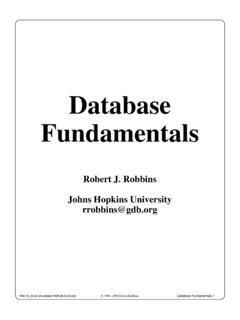Transcription of 10 Disruptive trends in wealth management - Deloitte US
1 10 disruptive trends in wealth management i10 Disruptive trends in wealth management110 Disruptive trends in wealth management 2 wealth management (WM)1 is one of the most attractive sectors within financial services for at least two reasons: First, WM businesses tend to have greater growth prospects, lower capital requirements, and a higher return on equity (ROE) than most other retail banking businesses, hence their appeal to diversified financial services firms at a time when capital is viewed as more expensive, growth is hard to come by, and equity returns for the banking industry are close to the cost of capital. Second, WM offerings are essential to attracting and retaining profitable retail customers. For instance, based on our experience, mass affluent customers can typically represent 80% or more of the net income generated by retail banks and they often regard their relationship with a provider of WM services as their most important financial relationship.
2 As result, many diversified financial services firms are doubling down on their WM WM industry is in the midst of significant change: a new generation of investors, whose expectations and preferences have been shaped by new technologies and by their living through the last financial crisis, have brought new standards to the industry in terms of how advice and investment products are being delivered. These new investors will control an increasing share of US retail assets over the next decade. Furthermore, a challenging investment environment, characterized by increased levels of uncertainty and rising costs of risk to investors and WM firms alike is making it harder for advisors to generate superior investment performance for their clients. Shifting demographics with the aging of advisors and an upcoming transfer of wealth from baby boomers to their children will upset many established advisor/client relationships and create opportunities for new firms to grow market share at the extent of incumbent firms.
3 Finally, increasing regulatory burdens, new business models and new competitive patterns all come together to further compound the level of disruption in the WM We define WM as the provision of financial advice and investment services to retail investors, ranging from low-income clients to High Net Worth (HNW) and Ultra High Net Worth (UHNW) individuals and firms and new business models as well as renewed commitment by incumbent WM firms will drive higher intensity of competition for the same clients and the same assets A new generation of investors think differently about advice bring new attitudes and expectations to the WM industry, influencing how older investors purchase and consume wealth servicesIncreasing regulatory burdens and rising costs of risks pose new challenges to WM firms and their parent companiesWith the rise of Robo Advisors, new combinations of science and human based advisory models have emergedThis is a challenging macro environment for investors and their advisors to find the right return/risk combinationsBig data and advanced analytics are on the cusp of transforming the WM industry.
4 With new ways to engage with new clients, manage client relationships and manage risksTwo demographic trends : (i) Advisors are aging and leaving the industry faster than firms are replacing them; (ii) wealth is about to change hands, upsetting established client/advisor relationshipsInvestors value holistic advice on how to achieve multiple, often conflicting goals through a range of investment and funding strategiesLongevity concerns increasingly are or should be at the heart of client-advisor conversations, even years ahead of retirement Retail investors are demanding access to the same asset classes and investment strategies as HNW or institutional investors 1234567891010 Disruptors to wealth management IndustryThe Re-wired InvestorScience- vs. Human-basedAnalytics and Big DataHolistic, Goals-based AdviceDemocratiza- tion of Asset Classes & Strategies Catching the Retirement WaveThe Aging of Advisors & Upcoming Transfer of WealthMacro Environment: 3 Lows and 2 HighsNew Competitive PatternsRising Costs of Risk and Increasing Regulatory BurdensWe have identified 10 principal sources of disruption in the WM industry today (Fig.)
5 1. the Wheel of Change is Turning on Our Industry). They are not independent of each other but rather tend to build on each other. Together they could profoundly change our industry in the next decade. WM firms will need to adapt to these disruptors and find new ways to create value for their clients. 10 disruptive trends in wealth management 4We speak of the Re-wired Investor to refer to new thinking patterns, standards and expectations by a new generation of investors. This new generation of investors include Gen X and Gen Y2 investors, but also baby boomers who have been influenced by their younger peers. The Re-wired investor thinks about advice differently from previous generations and expects to interact with her advisors in a different way. We have identified 9 new mentalities and six potential implications for WM firms (see Figure 2).
6 For instance, investors no longer want to be treated as part of a segment but instead as unique individuals ( Just me ) with specific goals and preferences. Instead they expect to receive advice tailored to their unique circumstances. Likewise, they want to stay in control of their financial lives and understand the advice they receive and make the important decisions themselves. They are reluctant to buy discretionary services and they are increasingly comfortable conducting their own research. The Re-wired Investor is more skeptical of authority than previous generations of investors. She believes in the wisdom of her peers. As a result, she is likely to seek opinions and views from multiple sources of advice simultaneously, including but not restricted to experts and financial advisors and often starting with people like her friends and colleagues.
7 With her expectations shaped by her interactions with non-financial digital firms ( , Google, Facebook, Amazon) as well as smartphones and other digital devices, she expects to be able to access advice anywhere and at any time, through multiple channels and devices as part of a cohesive, rich digital experience. The Re-wired Investor has come to view risk through a different lens: she perceives risk as downside, rather than volatility. As a result, advisors have had to emphasize capital markets and hedging strategies that seek downside protection more than traditional portfolio allocations that seek to manage risk through diversification. Lastly, she feels entitled to the same investment products and strategies available to Ultra High Net Worth (UHNW) or even institutional investors forcing WM firms to think through new ways to give their retail investors access to alternative investments and new asset classes beyond traditional fixed income and equities, as well as active strategies.
8 The Re-wired Investor is likely here to stay and her influence over the rest of the investor class is likely to increase. Accordingly, WM firms and their advisors should adjust their offerings and service delivery models to win the battle for the Re-wired Investor the investor of the The re-wired investor2 Gen X, the approximately 45 million Americans born in the late 1960s and 1970s, and Gen Y, the approximately 60 million Americans born in the 1980s and first half of 1990sJust meDigital & PersonalStay in controlWisdom of my tribeDo it yourselfSkeptical of authorityAnywhere, anytimeRisk defined as downsideNot a Second Class InvestorMentalities of the Re-Wired InvestorBespokeInvestment advice and products perceived to be tailored to individuals one at a timeMultiple sources of adviceNot just from one advisor, but from other advisors, peers, experts.
9 Social mediaRisk management as HedgingDownside protection and hedging more than diversificationMulti-channelAccess to multiple channels and several advisory models at the same timeRich digital front endExpectations formed interacting with non- FIs; must be simple, intuitive, self-directedDemocratization of investmentsAccess to same high yield assets & strategies once available only to wealthier investorsImplications for WM firmsFigure 2: The Re-Wired Investor The Re-wired investor is here to stay and his influence over the rest of the US investor class is likely to increase. 5 Technology is poised to change the nature and delivery of financial advice in some significant ways, much as it has transformed other industries such as tax preparation, taxi booking, and accommodations, to mention just a few. In the last five years, a number of robo advisors have emerged.
10 These firms leverage client survey data into complex algorithms that produce customized financial plans and asset allocations. They also help investors find relevant research within an ever-growing universe of studies, interviews, and market commentaries. Some firms have also pioneered tools and methodologies that generate real-time trade and investment recommendations tailored to individual investors history and preferences. Once the models and algorithms have been built and tested, investing and trading tools can be made available to customers with limited human intervention, emphasizing the shift from human-based, person-to-person advice to science-based, model-driven advisors are growing in popularity and have gained traction in the marketplace but still have quite a bit of room for growth. A survey by consulting firm Corporate Insight finds that total assets managed by the 11 leading robo advisors in the US rose 65% over the past year, hitting $19 billion in December While significant, this figure represents less than of the $33 trillion retail investable assets in the Furthermore, with aggressive pricing (~ of AUM)5 the potential for the current generation of robo advisors to generate meaningful bottom line and create a return for the Venture Capital firms behind many of them is still , robo advisors present the potential for significant market disruption.
















